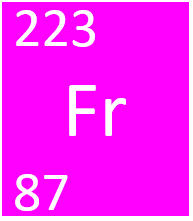Difference between revisions of "Francium"
| Line 4: | Line 4: | ||
==Key Stage 3== | ==Key Stage 3== | ||
===Meaning=== | ===Meaning=== | ||
| − | [[File: | + | [[File:FranciumSymbol1.png|right|300px|thumb|The [[Chemical Symbol|chemical symbol]] for [[Francium]].]] |
[[Francium]] is a [[Group 1]] [[element]], on the [[Periodic Table]], with an [[Atomic Number|atomic number]] of 87. | [[Francium]] is a [[Group 1]] [[element]], on the [[Periodic Table]], with an [[Atomic Number|atomic number]] of 87. | ||
===About Francium=== | ===About Francium=== | ||
Revision as of 21:22, 2 April 2019
Contents
Key Stage 2
Meaning
Key Stage 3
Meaning
Francium is a Group 1 element, on the Periodic Table, with an atomic number of 87.
About Francium
Molecular Structure
- Francium has the chemical symbol Fr.
- Francium atoms join together in large numbers to form a giant metal molecule.
Atomic Structure
- Francium as 87 protons and 136 neutrons in its nucleus giving it an Atomic Number of 87 and an atomic mass of 223.
- An atom of Francium has only 1 electron in its outer shell.
Properties
- Francium is the most reactive alkali metal.
- Francium does not exist in nature but has been created by scientists.
- Francium would react strongly with water to produce Hydrogen gas and Francium Hydroxide.
Key Stage 4
Meaning
Francium is a Group 1 element, on the Periodic Table, with 87 protons in the nucleus.
About Francium
Molecular Structure
- Francium has the chemical symbol Fr.
- Francium atoms join together in a giant metallic structure.
Atomic Structure
- The most stable isotope of Francium has 136 neutrons in its nucleus giving it an atomic mass of 223.
- An atom of Francium has only 1 electron in its outer shell.
- Francium ions have lost an electron to become positively charged.
Properties
- Francium is the most reactive alkali metal.
- Francium does not exist in nature but has been produced in small quantities in particle accelerators.
- Francium would react strongly with water to produce Hydrogen gas and Francium Hydroxide.
